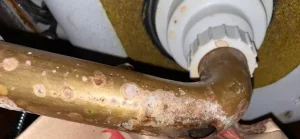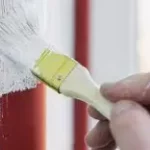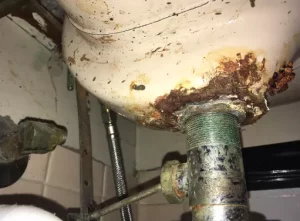Drains are like the body’s hidden veins, discreetly transporting waste to keep your plumbing running smoothly. Though many kitchen sink pipes are now of plastic construction, older homes generally rely on metal drainpipes.
Because they are usually out of sight, they often go unnoticed until they corrode and leak. Rust is terrible because it weakens the metal in your kitchen sink pipes by removing vital coatings.
It eats away at the pipe and enables holes to form leading to leakage. Rust develops through a reaction between galvanized steel and copper piping where the water is charged, stripping the galvanized coating.
It takes over if you wait too long, and it can cost you a lot of money to replace the piping system.
Rust in kitchen sink pipes is caused by changed pH levels and temperature, and water with chemicals that corrode the metal. To solve this problem, you can use rust removers and clean the pipes. Also, painting the pipes is a good way to prevent such corrosion.
Let us look at these causes, solutions, and preventive measures one by one.
Causes of Rusting in Kitchen Sink Pipes
Water passing through older, rusted galvanized pipes is the leading cause of rust. The iron and mineral residue left on the surface by hard water can create rust. Rust also occurs due to corrosion of the kitchen sink pipes.

The most common causes of kitchen sink pipe corrosion include:
- Water pH levels
- An excess of oxygen in water causes rust
- Very hot water can exacerbate corrosion
- Minerals in the water, particularly calcium, cause mineral accumulation
- Chemical drain cleaners usually wreak havoc on your plumbing system
Take immediate action if you suspect that your pipes suffer from corrosion. Corrosion can cause expensive repairs and major health problems. Therefore, you must take action right away. Even if you haven’t noticed any signs of corrosion yet, and you know you have galvanized or copper pipes, have an experienced plumber inspect them.
How to Fix Rusted Kitchen Sink Pipes
Flushing the pipes is the simplest approach to removing rust deposits. Open three or four cold water faucets throughout the home and run them at full pressure for roughly 20 minutes.
It should clear the pipes of rust particles, but if it doesn’t, wait about 30 minutes before flushing them again.
To clean rust out of galvanized water pipes:
- Check to determine if the galvanized pipes have developed a rust problem. If there is a rust deposit in the pipe, it will most certainly be visible since it restricts the water flow.
- Get a chemical pipe cleaner
- Clean the pipe with the pipe cleaner
- Run water through the pipe
If you have rusty pipes, the solution is to paint over them. It keeps the rust contained and prevents it from feeding on the metal. However, before you do that, you will want to get rid of as much rust as possible.
Options for removing the rust
- Rust-removers are chemical agents that thoroughly remove rust. If you choose to utilize one of these, you have several options available, all of which can provide a smooth surface for painting.
- Scrub the rust away with wire brushes. These brushes resemble toothbrushes in appearance. It requires a lot of elbow room but involves no chemicals. In the end, it will be just as effective as using a chemical rust remover.
- Sandpaper. After the wire brush has completed its work, you can use fine sandpaper to remove mild rust or create a very smooth painting surface.
- Combination. You might remove most of the rust with a wire brush, then finish with a chemical rust remover. Some people believe this is important for some jobs where one way may not be sufficient.
Painting the rusted pipe
Oil-based enamel paint is the finest choice for this project.

Oil-based paints produce a lot of fumes and take a long time to cure, but the result is long-lasting.
You have the option of using spray-on or brush-on paints.
Spraying on paint is convenient, especially if you are painting a section of pipe that you can’t get too near due to the surface.
However, it is evident that getting the paint only where you want it is a challenge.
It is easier to control if you use a brush. In both cases, the paint quality is the same.
- Primers. You can buy a primer to go under your paint, but it is unnecessary, just like the rust removers. Special primers help smooth out rust and create a good, paintable surface. You can accomplish the same thing using sandpaper.
- Choosing paint colors. In this DIY repair, the paint is the most crucial aspect. Rust-Oleum oil-based enamels have given me excellent results, and they come in a wide range of hues.
- Applying the paint. This is a simple step, and I simply have a few suggestions. If it is an outside project, choose a day that appears to be sunny, and be prepared to cover your paint job with an umbrella if rain unexpectedly falls. Don’t overfill your brush with paint. To ensure that it sticks well, use forceful strokes. Ensure you completely cover the pipe with paint.
That’s all there is to it. Removing the rust and coating the pipe with paint preserves it for a long time. When there are pipe issues, homeowners are typically afraid to call a plumber. Yet doing so is the best approach to undertake quick repairs.
The point is that you, as a homeowner, are accountable for the home’s upkeep. If the pipe system begins to show signs of trouble, you must act promptly to get it repaired; otherwise, you risk incurring a considerably higher fee and maybe losing your property.
How to Prevent Kitchen Sink Pipes from Rusting
Checking your drains carefully and regularly is one of the most effective strategies to combat rusting. If you notice rust around the plugholes in your bath or sink, it could be an indication that there’s more danger lurking below.

Exposing the iron in your water to a particular level of humidity will cause your drains to clog.
While a water filter is a long-term solution, you will need to unclog your drains using a chemical or natural high-quality drain cleaner in the near term.
Chlorine can also help but only used with expert guidance. Chlorinating the water can assist reduce the likelihood of germs forming. However, because it can also cause corrosion, it is best to leave this job to a trained drain specialist.
Routine inspections are beneficial because prevention is usually better than cure. Routine checks regularly can help you avoid problems like rust. You’ll probably save a lot of money in the long run if you do this; even simple things like clearing the drains can assist.
This is accomplished by filling the sinks and then removing the plug, which completely flushes the drains and removes any dirt adhering to the sides. Bleach can also be used overnight and is quite effective.
Common Kitchen Sink Pipe Maintenance Tips
It is essential to clean, clear, and freshen your kitchen sink drain and garbage disposal regularly. Pour boiling water down the drain every couple of weeks to dislodge any build-up in metal pipes. You can also use vinegar to help remove bacteria and odors while keeping the drain running and the liquid flowing freely.
Put a few scoops of ice down the garbage disposal after the boiling water and run it until the ice is gone. The contact on the blades will assist release any buildup and maintaining them clean.
Commercially available garbage disposal cleaners can help freshen the drain; if you use them, make sure to follow the package’s instructions.

As a homeowner, I am specifically keen on home improvement. I am passionate about homes, yards, and home improvement. I blog on home ideas and reviews on solutions that make homes better.